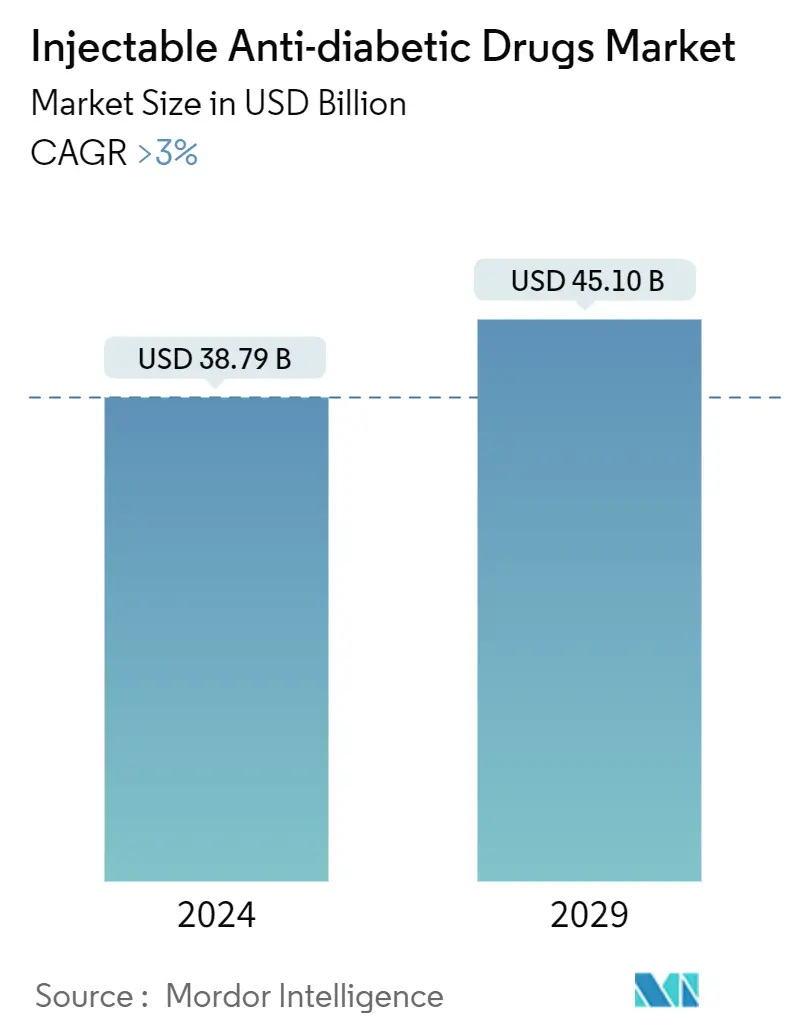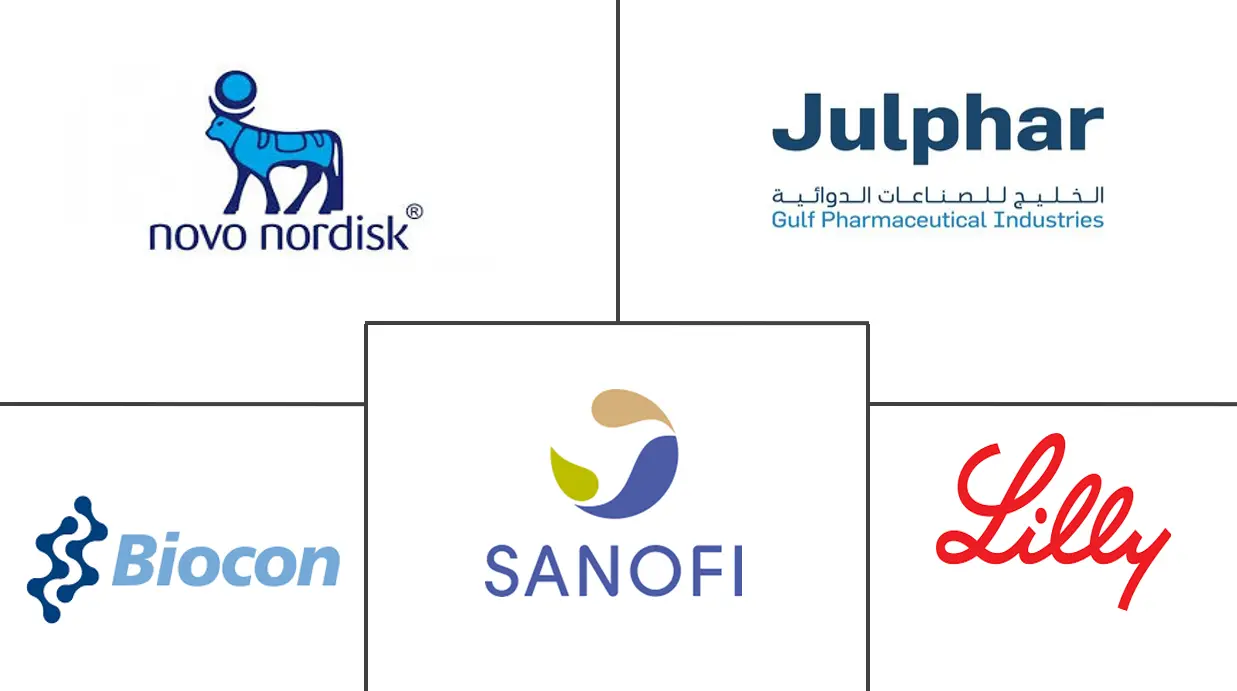Market Size of Injectable Anti-diabetic Drugs Industry

| Study Period | 2018-2029 |
| Market Size (2024) | USD 38.79 Billion |
| Market Size (2029) | USD 45.10 Billion |
| CAGR (2024 - 2029) | 3.00 % |
| Fastest Growing Market | North America |
| Largest Market | North America |
Major Players
*Disclaimer: Major Players sorted in no particular order |
Injectable Anti-diabetic Drugs Market Analysis
The Injectable Anti-diabetic Drugs Market size is estimated at USD 38.79 billion in 2024, and is expected to reach USD 45.10 billion by 2029, growing at a CAGR of greater than 3% during the forecast period (2024-2029).
The COVID-19 pandemic co-morbidities included hypertension, diabetes, cardiovascular disease, and cancer. According to an article,” 89-LB: COVID-19 Outcomes in Patients Who Started GLP1-RAs during Hospitalization,” published by the American Diabetes Association in June 2022, glucagon-like peptide-1 receptor agonists (GLP-1 RAs) were considered beneficial in improving COVID-19 outcomes due to their anti-inflammatory properties. Patients admitted for severe interstitial bilateral pneumonia in the COVID-19 ward due to SARS-COV2 infection and having type 2 diabetes or in-hospital hyperglycemia were treated with GLP-1 RAs in addition to standard therapy.
Diabetes is a chronic condition characterized by high levels of glucose in the blood caused by the inability to produce insulin or use insulin effectively, or both. The main types of diabetes are type 1 diabetes and type 2 diabetes. For a patient with type 1 diabetes, insulin therapy is important for replacing the insulin that the body doesn't produce. People with type 2 diabetes or gestational diabetes need insulin therapy if other treatments, such as diabetes medications and other lifestyle changes, are not able to keep blood glucose levels within the desired range. Diabetes treatment aims to maintain healthy blood glucose levels to prevent both short and long-term complications, such as cardiovascular disease, kidney disease, blindness, and lower limb amputation.
Glucagon-like peptide-1 receptor agonists (GLP-1RAs) are a class of medications used for the treatment of type 2 diabetes, and some drugs are also approved for obesity. One of the benefits of this class of drugs over older insulin secretagogues, such as sulfonylureas or meglitinides, is that they have a lower risk of causing hypoglycemia. Besides being important glucose-lowering agents, GLP-1RAs have significant anti-inflammatory and pulmonary protective effects and an advantageous impact on gut microbes’ composition.
In November 2022, the EU Commission and its members demonstrated political commitment. They set ambitious targets to “reduce inequalities between EU citizens and improve the care and quality of life of people living with diabetes.” The experts emphasized the importance of ensuring effective, accessible, and uninterrupted treatments to reduce the risk of developing complications. The authors of the resolution also emphasized the importance of data collection standardization. They highlighted the role of the Commission’s ‘Healthier Together’ initiative, launched in December 2021, which aimed to prevent, manage, and treat non-communicable diseases. The resolution calls on member states to develop, implement, and monitor national diabetes plans and strategies with” comparable milestones and targets” in recognition of inequalities in public health strategies and care as well as access to healthy and sustainable food across member states.
Therefore, owing to the factors above, the studied market is anticipated to witness growth over the analysis period.
Injectable Anti-diabetic Drugs Industry Segmentation
Injectable anti-diabetic Drugs composed of GLP-1 receptor agonists are a type of non-insulin medication that is used in combination with diet and exercise to help treat type 2 diabetes and insulin. The injectable anti-diabetic drugs market is segmented into drugs (dulaglutide, exenatide, ligarglutide, lixisenatide, and semaglutide), brands (byetta, bydureon, victoza, trulicity, lyxumia, and ozempic), and geography (North America, Europe, Asia-Pacific, the Middle East and Africa, and Latin America). The report offers the value (in USD) and volume (in units) for the above segments.
| Insulin | |
| Basal or Long-acting Insulins | |
| Bolus or Fast-acting Insulins | |
| Traditional Human Insulins | |
| Combination Insulins | |
| Biosimilar Insulins |
| Glucagon-like peptide-1 (GLP-1) agonists drugs | |
| Dulaglutide | |
| Exenatide | |
| Liraglutide | |
| Lixisenatide | |
| Semaglutide |
| Geography | |||||||||||||
| |||||||||||||
| |||||||||||||
| |||||||||||||
| |||||||||||||
|
Injectable Anti-diabetic Drugs Market Size Summary
The injectable anti-diabetic drugs market is poised for significant growth over the forecast period, driven by the increasing prevalence of diabetes and the rising demand for effective treatment options. This market encompasses a range of medications, including glucagon-like peptide-1 receptor agonists (GLP-1 RAs), which are particularly noted for their dual role in managing blood glucose levels and providing cardiovascular benefits. The market's expansion is further supported by technological advancements and regulatory approvals that enhance treatment options and accessibility. The COVID-19 pandemic highlighted the importance of these drugs, as they were found to have beneficial effects on patients with diabetes, improving outcomes in those hospitalized with severe COVID-19 symptoms. The focus on reducing health inequalities and improving diabetes care, especially in regions like the European Union, underscores the market's potential for growth.
North America currently holds a dominant position in the injectable anti-diabetic drugs market, with significant contributions from major players such as Eli Lilly, Novo Nordisk, and Sanofi. These companies are actively engaged in strategic collaborations and innovations to expand their market share and enhance product offerings. The market is characterized by a consolidated structure, with key manufacturers leveraging mergers and acquisitions to strengthen their presence. The introduction of new formulations and the approval of novel delivery methods, such as oral insulin, are expected to further drive market growth. Additionally, government initiatives and health policies aimed at addressing the rising incidence of diabetes and obesity are likely to contribute to the market's upward trajectory.
Injectable Anti-diabetic Drugs Market Size - Table of Contents
-
1. MARKET DYNAMICS
-
1.1 Market Overview
-
1.2 Drivers
-
1.3 Restraints
-
1.4 Porter's Five Forces Analysis
-
1.4.1 Bargaining Power of Suppliers
-
1.4.2 Bargaining Power of Consumers
-
1.4.3 Threat of New Entrants
-
1.4.4 Threat of Substitute Products and Services
-
1.4.5 Intensity of Competitive Rivalry
-
-
-
2. MARKET SEGMENTATION
-
2.1 Insulin
-
2.1.1 Basal or Long-acting Insulins
-
2.1.2 Bolus or Fast-acting Insulins
-
2.1.3 Traditional Human Insulins
-
2.1.4 Combination Insulins
-
2.1.5 Biosimilar Insulins
-
-
2.2 Glucagon-like peptide-1 (GLP-1) agonists drugs
-
2.2.1 Dulaglutide
-
2.2.2 Exenatide
-
2.2.3 Liraglutide
-
2.2.4 Lixisenatide
-
2.2.5 Semaglutide
-
-
2.3 Geography
-
2.3.1 North America
-
2.3.1.1 United States
-
2.3.1.2 Canada
-
2.3.1.3 Rest of North America
-
-
2.3.2 Europe
-
2.3.2.1 Germany
-
2.3.2.2 Spain
-
2.3.2.3 Italy
-
2.3.2.4 France
-
2.3.2.5 United Kingdom
-
2.3.2.6 Russia
-
2.3.2.7 Rest of Europe
-
-
2.3.3 Asia-Pacific
-
2.3.3.1 Japan
-
2.3.3.2 China
-
2.3.3.3 Australia
-
2.3.3.4 India
-
2.3.3.5 South Korea
-
2.3.3.6 Malaysia
-
2.3.3.7 Indonesia
-
2.3.3.8 Thailand
-
2.3.3.9 Philippines
-
2.3.3.10 Vietnam
-
2.3.3.11 Rest of Asia-Pacific
-
-
2.3.4 Latin America
-
2.3.4.1 Brazil
-
2.3.4.2 Mexico
-
2.3.4.3 Rest of Latin America
-
-
2.3.5 Middle East and Africa
-
2.3.5.1 South Africa
-
2.3.5.2 Saudi Arabia
-
2.3.5.3 Oman
-
2.3.5.4 Egypt
-
2.3.5.5 Iran
-
2.3.5.6 Rest of Middle East and Africa
-
-
-
Injectable Anti-diabetic Drugs Market Size FAQs
How big is the Injectable Anti-diabetic Drugs Market?
The Injectable Anti-diabetic Drugs Market size is expected to reach USD 38.79 billion in 2024 and grow at a CAGR of greater than 3% to reach USD 45.10 billion by 2029.
What is the current Injectable Anti-diabetic Drugs Market size?
In 2024, the Injectable Anti-diabetic Drugs Market size is expected to reach USD 38.79 billion.

